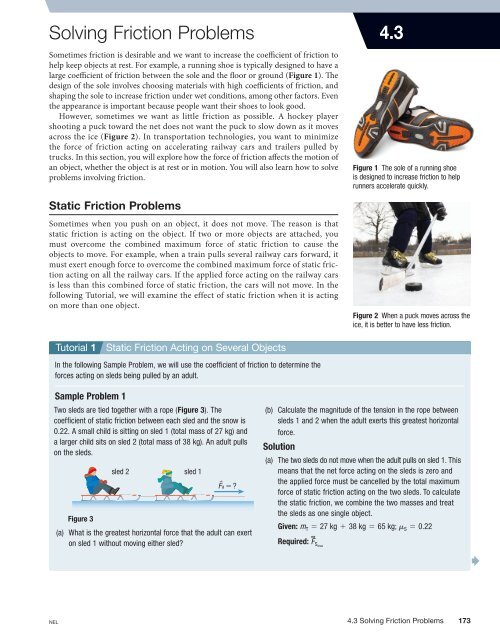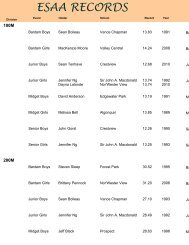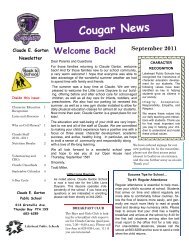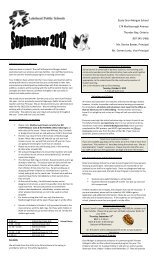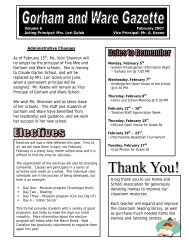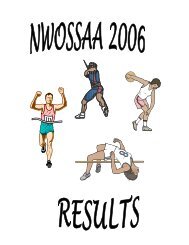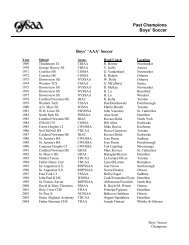Solving Friction Problems 4.3 - Lakehead Public Schools
Solving Friction Problems 4.3 - Lakehead Public Schools
Solving Friction Problems 4.3 - Lakehead Public Schools
You also want an ePaper? Increase the reach of your titles
YUMPU automatically turns print PDFs into web optimized ePapers that Google loves.
<strong>Solving</strong> <strong>Friction</strong> <strong>Problems</strong><br />
Sometimes friction is desirable and we want to increase the coeffi cient of friction to<br />
help keep objects at rest. For example, a running shoe is typically designed to have a<br />
large coeffi cient of friction between the sole and the fl oor or ground (Figure 1). Th e<br />
design of the sole involves choosing materials with high coeffi cients of friction, and<br />
shaping the sole to increase friction under wet conditions, among other factors. Even<br />
the appearance is important because people want their shoes to look good.<br />
However, sometimes we want as little friction as possible. A hockey player<br />
shooting a puck toward the net does not want the puck to slow down as it moves<br />
across the ice (Figure 2). In transportation technologies, you want to minimize<br />
the force of friction acting on accelerating railway cars and trailers pulled by<br />
trucks. In this section, you will explore how the force of friction aff ects the motion of<br />
an object, whether the object is at rest or in motion. You will also learn how to solve<br />
problems involving friction.<br />
Static <strong>Friction</strong> <strong>Problems</strong><br />
Sometimes when you push on an object, it does not move. The reason is that<br />
static friction is acting on the object. If two or more objects are attached, you<br />
must overcome the combined maximum force of static friction to cause the<br />
objects to move. For example, when a train pulls several railway cars forward, it<br />
must exert enough force to overcome the combined maximum force of static friction<br />
acting on all the railway cars. If the applied force acting on the railway cars<br />
is less than this combined force of static friction, the cars will not move. In the<br />
following Tutorial, we will examine the effect of static friction when it is acting<br />
on more than one object.<br />
Tutorial 1 Static <strong>Friction</strong> Acting on Several Objects<br />
In the following Sample Problem, we will use the coeffi cient of friction to determine the<br />
forces acting on sleds being pulled by an adult.<br />
Sample Problem 1<br />
Two sleds are tied together with a rope (Figure 3). The<br />
coeffi cient of static friction between each sled and the snow is<br />
0.22. A small child is sitting on sled 1 (total mass of 27 kg) and<br />
a larger child sits on sled 2 (total mass of 38 kg). An adult pulls<br />
on the sleds.<br />
NEL<br />
Figure 3<br />
sled 2<br />
sled 1<br />
Fa ?<br />
(a) What is the greatest horizontal force that the adult can exert<br />
on sled 1 without moving either sled?<br />
<strong>4.3</strong><br />
Figure 1 The sole of a running shoe<br />
is designed to increase friction to help<br />
runners accelerate quickly.<br />
Figure 2 When a puck moves across the<br />
ice, it is better to have less friction.<br />
(b) Calculate the magnitude of the tension in the rope between<br />
sleds 1 and 2 when the adult exerts this greatest horizontal<br />
force.<br />
Solution<br />
(a) The two sleds do not move when the adult pulls on sled 1. This<br />
means that the net force acting on the sleds is zero and<br />
the applied force must be cancelled by the total maximum<br />
force of static friction acting on the two sleds. To calculate<br />
the static friction, we combine the two masses and treat<br />
the sleds as one single object.<br />
Given: mT 5 27 kg 1 38 kg 5 65 kg; mS 5 0.22<br />
Required: F ><br />
Smax <strong>4.3</strong> <strong>Solving</strong> <strong>Friction</strong> <strong>Problems</strong> 173
-OP11USB<br />
Practice<br />
(1st pass 7381-A)<br />
Analysis: m S 5 F S max<br />
F N<br />
Solution: F Smax 5 m SF N<br />
5 m Sm Tg<br />
5 10.222 165 kg2 19.8 m/s 2 2<br />
F Smax 5 140 N<br />
Statement: The greatest horizontal force that the adult<br />
can exert on sled 1 without moving either sled is<br />
140 N [forward].<br />
(b) Draw the FBD for sled 2 (Figure 4).<br />
F Smax Figure 4<br />
F N<br />
F g<br />
Keep in mind that sled 2 does not move, which means the<br />
net force is zero. In this case, the tension and the static<br />
friction acting on sled 2 will cancel.<br />
Given: m 5 38 kg; mS 5 0.22<br />
Required: F T<br />
Analysis: Since F T 5 F Smax , calculate F Smax using m S 5 F S max<br />
F N<br />
Solution: F Smax 5 m SF N<br />
5 m Smg<br />
5 10.222 138 kg2 19.8 m/s 2 2<br />
F Smax 5 82 N<br />
1. Two trunks sit side by side on the fl oor. The larger trunk (52 kg) is to the left of the<br />
smaller trunk (34 kg). A person pushes on the larger trunk horizontally toward the<br />
right. The coeffi cient of static friction between the trunks and the fl oor is 0.35. T/i<br />
(a) Determine the magnitude of the maximum force the person can exert without<br />
moving either trunk. [ans: 290 N]<br />
(b) Calculate the force the larger trunk exerts on the smaller trunk. [ans: 120 N [right]]<br />
(c) Would either answer change if the person pushed in the opposite direction on the<br />
smaller trunk? Explain your reasoning.<br />
2. A 4.0 kg block of wood sits on a table (Figure 5). A string is tied to the wood,<br />
running over a pulley and down to a hanging object. The greatest mass that can be<br />
hung from the string without moving the block of wood is 1.8 kg. Calculate the coeffi cient<br />
of static friction between the block of wood and the table. T/i [ans: 0.45]<br />
Figure 6 When starting a race, an<br />
athlete can achieve a greater forward<br />
acceleration by pushing backwards on<br />
starting blocks.<br />
F T<br />
Statement: The magnitude of the tension in the rope is 82 N.<br />
Static <strong>Friction</strong> and Motion<br />
It is important to understand that static friction acts on an object when the object is<br />
at rest on a surface. Th is does not mean that static friction cannot be used to make an<br />
object move. For example, when you take a step forward, the bottom of your shoe is<br />
at rest with respect to the ground. Th e foot you are standing on is not actually moving<br />
forward with the rest of your body. Th e action force is you pushing backwards on the<br />
ground. According to Newton’s third law, the ground pushes back on your foot with a<br />
force of equal magnitude but opposite in direction (the reaction force). Th is reaction<br />
force is the force of static friction, and it is this force that actually pushes you forward.<br />
Keep in mind that the force of static friction is usually greater in magnitude than<br />
the force of kinetic friction. Th is means that in a race from a standing start without<br />
starting blocks (Figure 6), you ideally want to push backwards with both feet, making<br />
sure your shoes do not slip. In the following Tutorial, we will examine the eff ect of<br />
static friction that causes an object to move.<br />
Ontario Physics 11 SB<br />
174 Chapter 4 • Applications of Forces0-17-650433-8 NEL<br />
FN C04-F013-OP11USB<br />
Figure 5<br />
4.0 kg<br />
pulley<br />
1.8 kg
Tutorial 2 Static <strong>Friction</strong> Can Cause Motion<br />
The following Sample Problem will demonstrate how to calculate the maximum magnitude<br />
of acceleration when the coefficient of static friction is given.<br />
Sample Problem 1<br />
The coefficient of static friction between a person’s shoe<br />
and the ground is 0.70. Determine the maximum magnitude<br />
of acceleration of the 62 kg person, if he starts running on a<br />
horizontal surface from rest.<br />
Given: mS 5 0.70; m 5 62 kg<br />
Required: a<br />
Analysis: Draw the FBD of the person (Figure 7).<br />
Practice<br />
kinetic <strong>Friction</strong> <strong>Problems</strong><br />
F N<br />
F g<br />
Figure 7<br />
F Smax In this case, the maximum force of static friction is the net<br />
force since the normal force and gravity cancel. First we<br />
need to calculate F Smax .<br />
F net 5 F Smax ; F Smax 5 m SF N<br />
Solution: F Smax 5 m SF N<br />
5 m Smg<br />
5 10.702 162 kg2 19.8 m/s 2 2<br />
F Smax 5 425.3 N 1two extra digits carried2<br />
Now calculate the magnitude of the acceleration:<br />
F net 5 F Smax<br />
ma 5 425.3N<br />
162 kg2a 5 425.3 N<br />
a 5 6.9 m/s 2<br />
1. Two people start running from rest. The first person has a mass of 59 kg and is wearing<br />
dress shoes with a coefficient of static friction of 0.52. The other person is wearing<br />
running shoes with a coefficient of static friction of 0.66. T/i<br />
(a) Calculate the maximum possible initial acceleration of the person wearing dress<br />
shoes. [ans: 5.1 m/s 2 [forward]]<br />
(b) Explain why we do not really need the mass of either person when finding the initial<br />
maximum possible acceleration.<br />
(c) Determine the ratio of the two accelerations and compare it to the ratio of the two<br />
coefficients of friction. [ans: 0.79; they are equal]<br />
2. A skater with mass 58 kg is holding one end of a rope and standing at rest on ice. Assume no<br />
friction. Another person with mass 78 kg is standing just off the ice on level ground and is holding<br />
the other end of the rope. The person standing on the ground pulls on the rope to accelerate the<br />
skater forward. The coefficient of static friction between the ground and the off-ice person is 0.65.<br />
Calculate the maximum possible acceleration of the skater. T/i [ans: 8.6 m/s 2 [toward off-ice person]]<br />
Statement: The maximum magnitude of the acceleration is<br />
6.9 m/s 2 .<br />
4-OP11USB When an object is sliding across a surface, kinetic friction acts on the object in a<br />
direction opposite to the direction of motion. One common misconception is that (a)<br />
F a<br />
kinetic friction always reduces the net force acting on an object. For example, in<br />
Sample Problem 1 in Tutorial 3, a person pushes against a sliding box to stop it from<br />
F a<br />
F K<br />
F net<br />
s (1st pass 7381-A) sliding any farther. In this situation, both the applied force and the kinetic friction<br />
act in the same direction (Figure 8(a)). So the magnitude of the net force is greater (b)<br />
than if the person applies a force in the opposite direction (Figure 8(b)). In the fol- Figure 8 (a) Both the applied force<br />
lowing Tutorial, we will examine how kinetic friction causes a moving object to come<br />
to rest.<br />
Oops! and friction Sorry act about in the same the direction, last pass.<br />
producing a large net force. (b) The applied<br />
force and kinetic friction act in opposite<br />
This is going to directions, be slightly producing wider a smaller than net a force. margin widt<br />
Can the length of the vectors be shortened to fit?<br />
<strong>4.3</strong> <strong>Solving</strong> <strong>Friction</strong> <strong>Problems</strong> 175<br />
NEL<br />
F K<br />
F net
Tutorial 3 Kinetic <strong>Friction</strong> and Motion<br />
The following Sample <strong>Problems</strong> will help to clarify the effect of kinetic friction on motion.<br />
Sample Problem 1: Stopping a Sliding Box<br />
A 250 kg box slides down a ramp and then across a level fl oor.<br />
The coeffi cient of kinetic friction along the fl oor is 0.20. A person<br />
sees the box moving at 1.0 m/s [left] and pushes on it with a<br />
horizontal force of 140 N [right].<br />
(a) How far does the box travel before coming to rest?<br />
(b) How will the results change if the box is moving right and<br />
the person still pushes right with the same force?<br />
Solution<br />
(a) Given: mK 5 0.20; m 5 250 kg; F ><br />
a 5 140 N 3right4<br />
Required: Dd<br />
Analysis: Draw the FBD of the box (Figure 9). Choose right<br />
and up as positive and left and down as negative. The kinetic<br />
friction must be opposite to the motion. We will fi rst determine<br />
the kinetic friction. We can then use the FBD to fi nd the<br />
acceleration. Once we have the acceleration, we can use one<br />
of the kinematics equations to calculate the distance.<br />
2 2 v2 5 v1 1 2aDd; FK 5 mK FN ; F ><br />
net 5 F ><br />
a 1 F ><br />
K<br />
direction of motion<br />
F N<br />
F g<br />
Sample Problem 2<br />
F a<br />
F K<br />
Figure 9<br />
Two sleds tied together are pulled across an icy surface with<br />
an applied force of 150 N [E] (Figure 10). The mass of sled 1<br />
is 18.0 kg and the mass of sled 2 is 12.0 kg. The coeffi cient of<br />
kinetic friction for each sled is 0.20.<br />
(a) Calculate the acceleration of the sleds.<br />
(b) Determine the magnitude of the tension in the rope between<br />
the sleds.<br />
Figure 10<br />
sled 2<br />
sled 1<br />
150 N [E]<br />
Solution<br />
(a) Both sleds move together with the same acceleration so we<br />
can treat them as one large object. The total mass of the two<br />
sleds is mT 5 18.0 kg 1 12.0 kg 5 30.0 kg.<br />
Solution: F K 5 m KF N<br />
5 m Kmg<br />
5 10.202 1250 kg2 19.8 m/s 2 2<br />
5 490 N<br />
Now calculate the acceleration.<br />
F ><br />
net 5 F ><br />
a 1 F ><br />
K<br />
ma 5 140 N 1 490 N<br />
1250 kg2a 5 630 N<br />
a 5 2.52 m/s2 a > 5 2.52 m/s 2 3right4 1one extra digit carried2<br />
Next calculate the distance travelled. Since we do not know<br />
the time, we use the kinematics equation v 2 2 5 v1 2 1 2aDd.<br />
2 2 v2 5 v1 1 2aDd<br />
2 2 v2 2 v1 5 2aDd<br />
Dd 5 v2 2 2 2 v1 2a<br />
Dd 5 02 2 121.0 m/s2 2<br />
212.52 m/s 2 2<br />
Dd 5 20.20 m<br />
Statement: The box moves 0.20 m before coming to rest.<br />
(b) In this situation, friction is directed toward the left. Since the<br />
applied force acts in the opposite direction, the net force will<br />
be smaller. So the acceleration will now also be smaller, and<br />
the box will travel farther before coming to rest.<br />
There is no need to consider the tension at this point<br />
because it is an internal force and does not contribute to the<br />
acceleration of the total mass.<br />
Draw the FBD of the two sleds (Figure 11). Choose east and<br />
up as positive and west and down as negative.<br />
Figure 11<br />
F N<br />
F K<br />
150 N [E]<br />
F g<br />
Given: m K 5 0.20; m T 5 30.0 kg; F ><br />
a 5 150 N 3E4<br />
176 Chapter 4 • Applications of Forces NEL
NEL<br />
Required: a ><br />
Analysis: F ><br />
net 5 ma > ; F ><br />
net 5 F ><br />
a 1 F ><br />
Solution: First we need to determine the force of kinetic friction.<br />
F K 5 m KF N<br />
5 m Km Tg<br />
5 10.202 130.0 kg2 19.8 m/s 2 2<br />
F K 5 58.8 N 1one extra digit carried2<br />
Now calculate the acceleration.<br />
F ><br />
net 5 F ><br />
a 1 F ><br />
K<br />
m Ta 5 150 N 2 58.8 N<br />
130.0 kg2a 5 91.2 N<br />
a 5 3.04 m/s2 Practice<br />
a > 5 3.0 m/s 2 3E4<br />
Statement: The acceleration of both sleds is 3.0 m/s 2 [E].<br />
K<br />
(b) To calculate the magnitude of the tension, we can use the<br />
FBD for sled 2.<br />
F N<br />
1. A 0.170 kg hockey puck is initially moving at 21.2 m/s [W] along the ice. The coeffi cient<br />
of kinetic friction for the puck and the ice is 0.005. T/i<br />
(a) What is the speed of the puck after travelling 58.5 m? [ans: 21.1 m/s]<br />
(b) After being played on for a while, the ice becomes rougher and the coeffi cient of<br />
kinetic friction increases to 0.047. How far will the puck travel if its initial and fi nal<br />
speeds are the same as before? [ans: 6.24 m]<br />
2. A snowmobile is used to pull two sleds across the ice. The mass of the snowmobile and<br />
the rider is 320 kg. The mass of the fi rst sled behind the snowmobile is 120 kg and the<br />
mass of the second sled is 140 kg. The ground exerts a force of 1500 N [forward] on<br />
the snowmobile. The coeffi cient of kinetic friction for the sleds on ice is 0.15. Assume<br />
that no other frictional forces act on the snowmobile. Calculate the acceleration of the<br />
snowmobile and sleds. T/i C [ans: 1.9 m/s2 [forward]]<br />
3. A string is tied to a 3.2 kg object on a table and a 1.5 kg object hanging over a pulley<br />
(Figure 12). The coeffi cient of kinetic friction between the 3.2 kg object and the table is<br />
0.30. T/i<br />
(a) Calculate the acceleration of each object. [ans: 1.1 m/s2 [R]; 1.1 m/s2 [down]]<br />
(b) Determine the magnitude of the tension in the string. [ans: 13 N]<br />
(c) How far will the objects move in 1.2 s if the initial velocity of the 3.2 kg object is<br />
1.3 m/s [right]? [ans: 2.4 m]<br />
4. An electric motor is used to pull a 125 kg box across a fl oor using a long cable. The<br />
tension in the cable is 350 N and the box accelerates at 1.2 m/s2 Ontario Physics 11 U<br />
0176504338<br />
FN<br />
C04-F019-OP11USB<br />
CO<br />
Nesbitt<br />
3.2 kg<br />
Pass<br />
3rd pass (1st pass 7381-A)<br />
Approved<br />
Not Approved<br />
[forward] for 5.0 s. Figure 12<br />
The cable breaks and the box slows down and stops. T/i C<br />
(a) Calculate the coeffi cient of kinetic friction. [ans: 0.16]<br />
(b) How far does the box travel up to the moment the cable breaks? [ans: 15 m]<br />
(c) How far does the box travel from the moment the cable breaks until it stops? [ans: 11 m]<br />
<strong>4.3</strong> Summary<br />
• Static friction exists between an object and a surface when the object is not<br />
sliding on the surface.<br />
• Static friction can be used to move objects.<br />
• Kinetic friction always acts in a direction that is opposite to the motion of the object.<br />
• The kinematics equations from Unit 1 can be used to solve some problems<br />
involving friction and other forces.<br />
F K<br />
F ><br />
net 5 F ><br />
T 1 F ><br />
K 2<br />
m 2a 5 F T 2 m Km 2g<br />
112.0 kg2 13.04 m/s 2 2 5 F T 2 10.202 112.0 kg2 19.8 m/s 2 2<br />
F T 5 60 N<br />
Statement: The magnitude of the tension in the rope is 60 N.<br />
F g<br />
F T<br />
pulley<br />
1.5 kg<br />
Investigation <strong>4.3</strong>.1<br />
Predicting Motion with <strong>Friction</strong><br />
(p. 194)<br />
In this investigation, you will calculate<br />
the acceleration of a system of objects<br />
using Newton’s laws. Then you will<br />
measure the actual acceleration.<br />
<strong>4.3</strong> <strong>Solving</strong> <strong>Friction</strong> <strong>Problems</strong> 177
<strong>4.3</strong> Questions<br />
1. During fundraising week at school, students decide to hold<br />
a competition of strength. Contestants pay $1 to try to<br />
move a heavy object. If they can move the object, they<br />
win $10. The object is a large box of books of mass<br />
250 kg, with a coeffi cient of static friction of 0.55. One<br />
student has a mass of 64 kg and a coeffi cient of friction of<br />
static friction of 0.72 for his shoes on the fl oor. T/i<br />
(a) What is the maximum force of static friction acting on<br />
the student?<br />
(b) What is the maximum force of static friction acting on<br />
the box?<br />
(c) Is the competition fair? Explain your reasoning.<br />
2. In an action movie, an actor is lying on an ice shelf and holding<br />
onto a rope. The rope hangs over a cliff to another actor who<br />
is hanging on in midair. The actor on the ice shelf has a mass<br />
of 55 kg and the actor hanging in midair has a mass of 78 kg.<br />
Neither actor can grab onto anything to help stop their motion,<br />
yet in the movie neither one is moving. T/i A<br />
(a) Calculate the minimum coeffi cient of static friction.<br />
(b) Is your answer to (a) reasonable considering that the<br />
surface is ice? Explain.<br />
(c) What could the director do to make the scene more<br />
realistic? Explain your reasoning.<br />
3. In a physics experiment on static friction, two objects made<br />
of identical material are tied together with string. The fi rst<br />
object has a mass of 5.0 kg and the second object has<br />
a mass of 3.0 kg. Students measure the maximum force<br />
of static friction as 31.4 N to move both objects across a<br />
horizontal surface. T/i<br />
(a) What is the coeffi cient of static friction?<br />
(b) What is the magnitude of the tension in the string if<br />
they pull on the fi rst object?<br />
(c) A student pushes the 3.0 kg object with a force of<br />
15.0 [down]. What are the magnitudes of the maximum<br />
force of static friction and the tension now?<br />
(d) Will your answers to (c) change if the student pushes<br />
down on the 5.0 kg object instead? Explain.<br />
4. A student puts a 0.80 kg book against a vertical wall and<br />
pushes on the book toward the wall with a force of 26 N [R].<br />
The book does not move. T/i<br />
(a) Calculate the minimum coeffi cient of static friction.<br />
(b) Describe two ways the student could make the book<br />
accelerate down without changing the applied force.<br />
5. A string is tied to a 4.4 kg block and a 120 g hanging bucket<br />
(Figure 13). Students add 20 g washers one at a time to<br />
the bucket. The students are unaware that the coeffi cient of<br />
static friction for the block on the table is 0.42. T/i<br />
Ontario Physics 11 SB<br />
0-17-650433-8<br />
FN<br />
CO<br />
Allan Moon<br />
Pass 1st pass<br />
Approved<br />
Not Approved<br />
(a) What is the maximum force of static friction for<br />
the block?<br />
(b) How many washers can the students add to the bucket<br />
without moving the block?<br />
C04-F022-OP11USB<br />
(c) Will this investigation yield an accurate result if they use<br />
it to fi nd the coeffi cient of static friction? Explain<br />
your reasoning.<br />
(d) The coeffi cient of kinetic friction is 0.34. Calculate<br />
the acceleration of the block when the fi nal washer is<br />
placed in the bucket and the objects start to move.<br />
4.4 kg<br />
Figure 13<br />
pulley<br />
120 g<br />
6. In a tug-of-war contest on a fi rm, horizontal sandy beach,<br />
team A has six players with an average mass of 65 kg and<br />
team B has fi ve players with an average mass of 84 kg.<br />
Team B, pulling with a force of 3.2 kN, dislodges team A<br />
and then decreases its force to 2.9 kN to pull team A<br />
across the sand at a constant velocity. Determine team A’s<br />
coeffi cient of<br />
(a) static friction (b) kinetic friction T/i<br />
7. Two students push a 260 kg piano across the fl oor. Kathy<br />
pushes with 280 N [forward] while Matt pushes with 340 N<br />
[forward]. The piano accelerates at 0.30 m/s2 [forward]. T/i<br />
(a) What is the coeffi cient of kinetic friction?<br />
(b) How long will it take the piano to stop moving after<br />
pushing it for 6.2 s from rest?<br />
8. A 65 kg sprinter accelerates from rest into a strong wind<br />
that exerts a frictional force of 62 N. The ground applies a<br />
constant forward force of 250 N on the sprinter’s feet. T/i<br />
(a) Calculate<br />
(i) the sprinter’s acceleration<br />
(ii) the distance travelled in the fi rst 2.0 s<br />
(iii) the minimum coeffi cient of friction between the<br />
sprinter’s shoes and the track<br />
(b) Is the friction applied on the sprinter from the ground<br />
static or kinetic? Explain.<br />
9. A homeowner accelerates a 15.0 kg lawnmower uniformly<br />
from rest to 1.2 m/s in 2.0 s. The coeffi cient of kinetic<br />
friction is 0.25. Calculate the horizontal applied force acting<br />
on the lawnmower. T/i<br />
10. A 75 kg baseball player is running at 2.8 m/s [forward]<br />
when he slides into home plate for a distance of 3.8 m<br />
before coming to rest. Calculate the coeffi cient of kinetic<br />
friction. T/i<br />
178 Chapter 4 • Applications of Forces NEL


